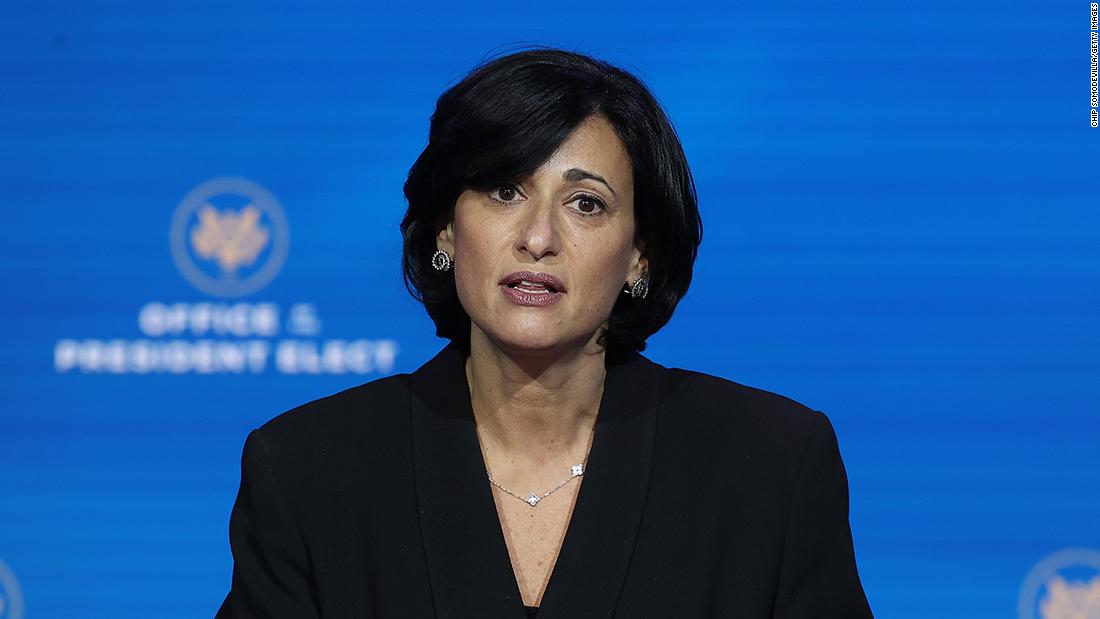And by February 13, that number could reach 508,000, according to a set forecast published by the CDC. The latest forecast, on January 13, projected up to 477,000 deaths by February 6.
In the meantime, vaccines have started to be distributed, but there are still significant challenges with supply across the country, according to state officials.
The new director of the CDC, Dr. Rochelle Walensky, on Wednesday described the number of victims of the pandemic as “truly painful”, but that “healthier days lie ahead” – although this requires rapid acceleration of testing, surveillance and vaccination.
She said the agency will be conducting a review of all its guidelines on the pandemic, so that “people can make decisions and act on the best available evidence”.
“We still have a lot of spread and a lot of that spread in our health systems and a lot of deaths from the disease. We still have a lot of work to do,” said Freeman.
Deaths in California and severity of cases remain high
Most coronavirus metrics have improved in California, an epicenter of the virus in the United States. But the seriousness of the cases in the state and the death toll remain high.
California added 22,403 new cases on Wednesday, which is well below the state’s average daily number of 38,000.
But it also reported 694 new Covid-19-related deaths on Wednesday, the second highest number of deaths in a single day so far. The previous high of 708 was recorded almost two weeks ago.
In Los Angeles, the death rate among patients hospitalized with Covid-19 has almost doubled in recent months.
Since November, patients hospitalized in Los Angeles County have had about a 23% chance of dying from the disease, health officials said on Wednesday. That rate marks a significant increase from the previous three months, when Covid-19 patients had an approximately 12% chance of dying, according to the county’s Department of Health Services.
Along with the death rate, the length of hospital stay for coronavirus in Los Angeles County jumped from about seven days between September and November to about nine and a half from November to January, suggesting that the severity of the disease in hospitalized people has increased, told LADHS.
“This trend does not mean that the virus has become more virulent or that hospital care has worsened during the outbreak,” explained Director of Health Services Christina Ghaly. “Instead, we believe that these trends occur because hospitals, facing capacity constraints in the context of the sudden increase, have become more selective in determining which patients to admit.
“In other words, hospitals are discharging low-acuity patients home with oxygen. They are admitting only the most serious patients.”
But with a limited supply of the coronavirus vaccine, state epidemiologist Erica Pan said it could take four to five months to vaccinate all Californians over 65.
‘A constant pattern of basically depletion’ of vaccine doses
The pressure to vaccinate people grew as authorities rushed to distribute doses to meet demand.
On Wednesday, more than 16.5 million doses were administered in the United States and nearly 2.2 million Americans are fully vaccinated, said the CDC.
New York Governor Andrew Cuomo said the state is administering about 65,000 doses a day – a rate that will exhaust its current supply in two or three days.
“What is clear now is that we will be going from week to week and you will see a constant pattern of basically running out, waiting for next week’s allocation and then starting over,” said Cuomo.
The state will receive 250,400 doses next week, but Cuomo asked Biden to increase supplies to the states immediately.
“With this current supply rate, it takes seven and a half months to get enough vaccine for the currently eligible population,” said Cuomo.
In Missouri, Governor Mike Parson said the state is in step with its vaccination plan, but that the National Guard will be activated to help manage it as the state expands eligibility to include first responders, emergency services and those in public health infrastructure.
A mass vaccination team will be set up in each of the state’s nine Highway Patrol regions, he said, and will be able to administer up to 2,500 doses per day.
The first weeks of spring may witness another boost in vaccinations, since WHO is evaluating 15 vaccines that it could list for emergency use, according to a new guidance document.
“I appeal to all countries to work together in solidarity to ensure that, in the first 100 days of this year, vaccination of health professionals and the elderly is underway in all countries,” said WHO Director-General Tedros Adhanom Ghebreyesus.
Virginia Langmaid, Haley Brink, CNN’s Ben Tinker, Matthew Hoye, Arlette Saenz, Cheri Mossburg, Sarah Moon, Julian Cummings, Deidre McPhillips, Jacqueline Howard and Kay Jones contributed to this report.
